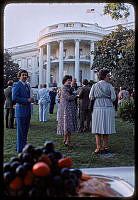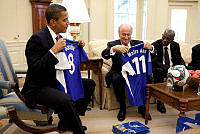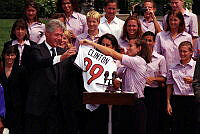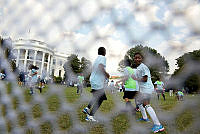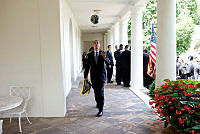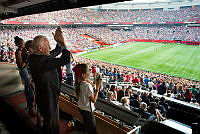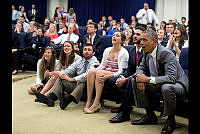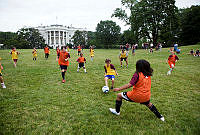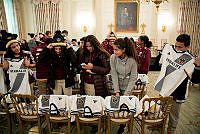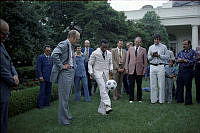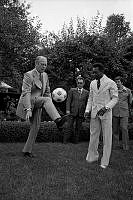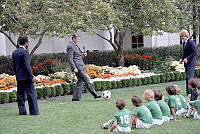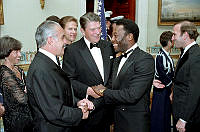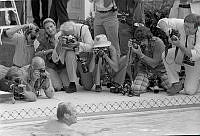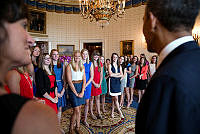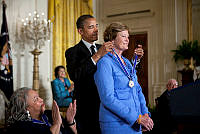Rubenstein Center Scholarship
A Pool for the President
Diving into the History of White House Swimming Pools
Gerald Ford was an avid swimmer, swimming twice a day in his backyard pool in Alexandria, Virginia. When President Ford moved into the White House, he no longer had immediate access to a pool. Although the White House had previously featured an indoor swimming pool, it was converted into the White House Press Room during Richard Nixon’s presidency.1

This black and white photograph depicts the indoor pool of the White House built in 1933 during the administration of President Franklin D. Roosevelt. In 1970, the indoor pool was converted into the White House Press Room. An outdoor pool replaced the indoor pool in 1975. Lorenzo Simmons Winslow designed the room with Douglas H. Gillette as an engineer.
National Archives and Records AdministrationThe original indoor swimming pool was installed in 1933 for President Franklin D. Roosevelt. Following Roosevelt’s 1921 polio diagnosis, he swam regularly for exercise. Shortly after he took office, The Daily News established a Roosevelt Swimming Pool Fund to raise money to construct a pool at the White House. The fund recognized the importance of a pool for the president’s use: “Swimming is the only sport in which he can indulge. It is the one sport which he enjoys to the utmost, which will keep him in perfect physical condition.” Within two weeks, the fund reached its goal to build the White House pool, raising over $12,000. Construction lasted three months and President Roosevelt took his first plunge on June 2, 1933.2

This 1963 photograph by Robert L. Knudsen depicts the White House indoor swimming pool as it appeared during the administration of President John F. Kennedy. The mural illustrating the U.S. Virgin Islands was painted by Bernard Lamotte and installed in the White House in 1962.
John F. Kennedy Presidential Library and Museum/NARAAlthough Harry Truman, John F. Kennedy, and Lyndon B. Johnson made frequent use of the indoor pool, Richard Nixon did not regularly use it. One article about the president’s fitness habits noted: “Nixon also likes to swim, but not indoors nor in fresh water.” In 1970, to accommodate the growing White House Press Corps, the pool was covered over with flooring and converted into the White House Press Room, today known as the James S. Brady Press Briefing Room. However, the project architect stated: “We were told in no uncertain terms that Nixon did not want any harm done to the pool, and the design of the press room must be done in such a way that the pool could be restored easily, apparently in case he received comments that he destroyed the FDR pool.”3
Before moving into the White House, President Ford lamented leaving behind his 20 by 40-foot heated backyard pool. Several days after taking office, he swam laps in his Alexandria pool as the press snapped photographs.4 Plans for a new White House pool quickly began to form and after initial remarks that he hadn’t “made a firm decision” about restoring the previous pool, President Ford later promised not to disturb the White House Press Room.5 Press Secretary Jerald terHorst fielded questions about a potential new pool and reiterated the president’s love of swimming, stating that he “really loves and needs this pool,” and quoted Ford as saying: “15 minutes in the pool is worth two martinis.”6

This is a photograph of President Gerald R. Ford and his daughter Susan Ford surveying the progress of construction on the new outdoor swimming pool on the South Grounds.
Gerald R. Ford Presidential Library and Museum/NARAUltimately, Ford spent no federal money to build the new pool. The pool, costing approximately $66,800, was financed by private donations, much like President Roosevelt’s indoor pool. On May 14, 1975, workers staked out an area for the pool on the South Lawn, approximately sixty feet south of the West Wing, and construction began the following day.7
During the pool’s excavation, archaeological reports and memos indicate the discovery of numerous artifacts. National Park Service Curator Robert Marshall noted in one memo, “I began salvage of artifacts early in the morning of May 15.” Since it was not possible to treat the pool dig as an archaeological site, sixteen truckloads of soil (approximately 11,000 cubic feet) were removed and taken to a National Park Service facility in Virginia. There, they dumped and spread the soil across a 60 by 160-foot area, measuring 1.2 feet deep. Artifacts were then collected from the soil and examined. Analysis revealed two primary types of artifacts: prehistoric Native American artifacts dating to the Woodland Period (1000 BCE-1000CE) and historic artifacts dating to the first half of the nineteenth century. The Native-American artifacts included: “seventeen chips, flakes, and other debris of quartz and quartzite, two quartz points, a broken biface or blank and fragment of pottery.” The nineteenth-century artifacts included glass, pottery, and building materials. The artifacts found suggest that the area was likely used as a trash pit for debris following the 1814 burning of the White House.8
Although pool construction briefly paused during this archaeological investigation, it soon resumed, and the pool was completed on June 30, 1975. The twenty-two by fifty-four-foot heated pool measured one third the size of an Olympic pool. It ranged in depth from three to nine feet and featured a diving board at the south end. President Ford took his first swim on July 1, 1975.9
Gallery
-

This black and white photograph by David Hume Kennerly shows President Gerald R. Ford swimming in the new White House swimming pool for reporters on July 5, 1975. The swimming pool is located on the South Grounds of the White House and is different from the one built in 1933 during the Franklin Roosevelt administration, which was indoors and covered over in 1970 to become the Press Room. President Ford's first swim in the pool came just a few days earlier, on July 1.
Gerald R. Ford Presidential Library and Museum/NARA -

This black and white photograph by David Hume Kennerly shows President Gerald R. Ford swimming the backstroke in the new White House swimming pool for reporters on July 5, 1975. The swimming pool is located on the South Grounds of the White House and is different from the one built in 1933 during the Franklin Roosevelt administration, which was indoors and covered over in 1970 to become the Press Room. President Ford's first swim in the pool came just a few days earlier, on July 1.
Gerald R. Ford Presidential Library and Museum/NARA
On July 5, the president met with members of the press poolside, wearing a dark purple swimsuit and a white terry cloth robe. He joked with reporters, “Shall I test the water? Then he dropped his robe onto the cement and climbed into the pool. With the press gathered around the pool furiously snapping photographs, President Ford proceeded to swim several laps. After a few freestyle, breast, and backstroke laps, the president told reporters: “this is a nicer pool than ours—by far. It’s just the right length. I hope to do about 40 laps a day.”10 Today, the White House swimming pool still stands south of the West Wing where presidents and first families can take a quick swim or throw a pool party.

This is a photograph of the outdoor pool installed for President Gerald R. Ford in May 1975. Bruce White photographed the pool on April 19, 2010.
White House Historical Association












